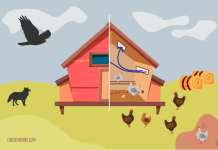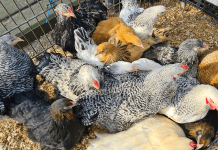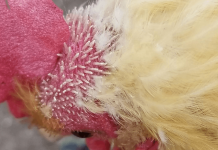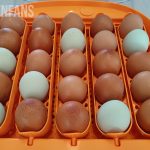How to Raise Chickens – The Complete Guide (2024)
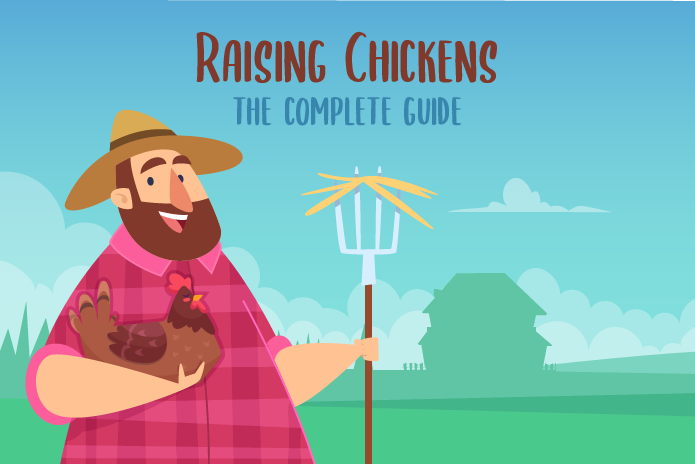
Raising chickens is easy. You just need to know a couple of things.
Let’s walk through every step.
Starting Off
How many chickens should you keep? Most people start with about three to six pullets in their backyard. Once the pullets are around 6 months old, they’re old enough to start laying, depending on their breed.
If you only want to keep chickens for your daily batch of fresh eggs, make sure you choose a top egg-laying breed.
Hens lay roughly four eggs every week, so that way, you will always have eggs available. Remember that hybrid chickens mostly won’t get older than four years, while heritage breeds can live up to ten years and older!
Most chicken breeds start laying at the age of 20 weeks, some a bit before and some later.
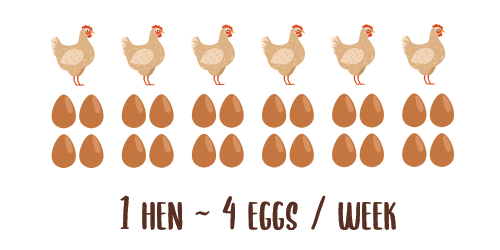
To house a chicken, you need at least about 3 square feet of space inside of the coop and 10 square feet of free run outside. Of course, the more, the better; it depends a little bit on the breeds in your flock (a flock is a group of chickens).
If you want to be sure, use our chicken coop calculator to make find out how much inside and outside space to provide!
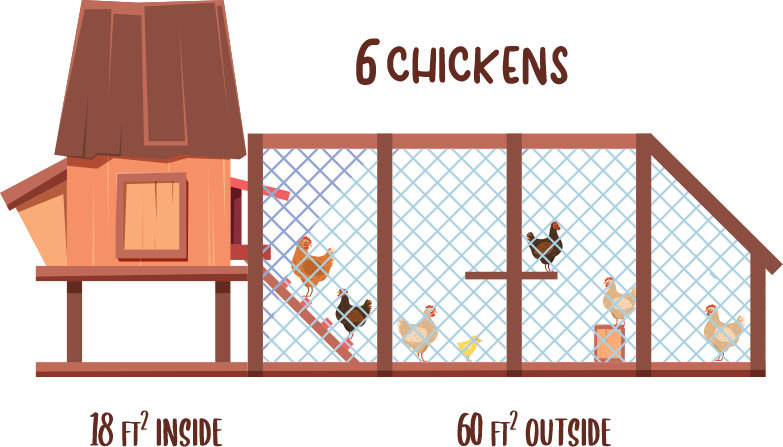
Now that you have an idea of the size of your flock, it’s time for the fun part: choosing your breeds.
Composing Your Flock
There are hundreds of breeds to choose from, so where do you start?
When looking at breeds, take the following into consideration:
- Egg vs. Meat: if you want to have eggs, make sure to select a breed for egg-laying. These breeds have lightweight hens that won’t be broody all the time. On the contrary, if you also want meat, search for breeds that are bred for meat or pick a dual-purpose breed.
- Climate: if you’re living in a warm climate, choose Mediterranean breeds like Leghorns. If you’re in a colder climate, choose chickens with larger bodies and smaller comb, such as Australorps.
- Egg Color: most chickens lay brown eggs, but some Mediterranean breeds produce white eggs. There are also breeds that lay blue eggs and olive eggs. The Easter Egger will lay eggs in any color and you will only find out what color after the hen starts laying.
- Looks: if you want your hens to show off on Instagram, make sure to choose a breed with feathered feet
- Attitude: if you are mixing breeds, make sure they have compatible personalities and traits. And if you want your flock to be fluffy and child-friendly, choose accordingly.
Check our beginner’s guide for chicken breeds if you need help selecting the right varieties that fit your situation. Or go to our Breed Page to find all breed articles.
Your perfectly crafted flock needs some shelter. Let’s see what a good chicken coop is all about.
Preparing Your Chicken Coop
Chicken coops come in all shapes and sizes, but every chicken coop should come with the same key ingrediënts.
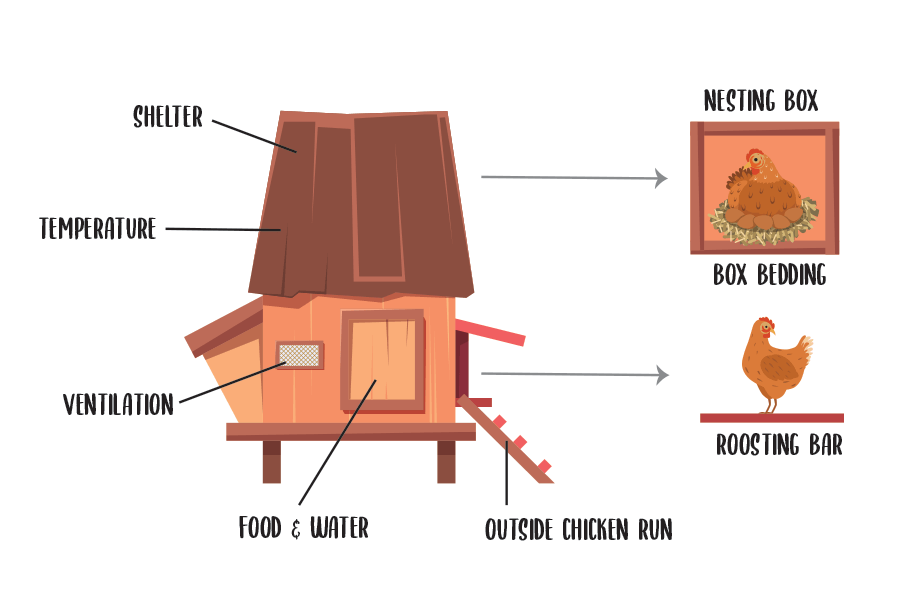
Nesting Box
Hens need quiet and safe nesting boxes to lay their eggs. Aim at one box for every 3 or 4 hens. They all tend to like the same box and keep snuggling together in the same box. You can use the chicken coop calculator to calculate the number of nesting boxes you need.
A nesting box should be around 12 inches tall, wide, and deep. Choosing the right nesting box bedding can be a bit tricky. You can use straw, hay, pine shavings, or nesting box pads. Some people even hang nesting box curtains to provide a secluded and dark area for your hens to lay eggs.
Before hens start laying eggs, you can train them with ping-pong balls or fake eggs. The first egg can be a bit smaller than normal eggs, called a fairy egg or fart egg.
It’s not unusual that a hen lays weirdly shaped eggs during their lifetime, and mostly it’s nothing to worry about. They can lay soft-shelled eggs, fairy eggs, eggs with a strange texture, or abnormally-shaped eggs.
Roosting Bar
Chickens sleep on a roosting bar high off the ground. They sleep together and sit next to each other on the roosting perch.
The roosting bar should be around 1,5 to 3 feet high but can be higher if you have a big chicken coop. Just make sure they can actually reach it. Hens don’t grip the perch but sleep with their feet flat, so the bar should be around two to four inches.
But at what time do chickens go to sleep? They go to roost about 30 minutes before twilight and wake up half an hour before dawn.
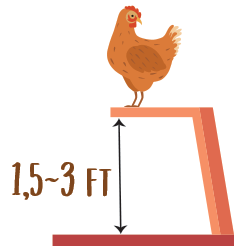
Food and Water
Food and water should be elevated from the ground so it stays fresh and clean. Hens drink about one cup a day. If you want to place the feeder outside, make sure to choose a rainproof feeder so the feed won’t get moist.
If your hens start drinking excessively, you might need to look into possible health problems.
The quality of the food is important if you want your chickens to lay big and healthy eggs. It contains proteins, vitamins, and other additives that the hens need.
To help your chickens live a happy and long life, supplementing their feed and water can be beneficial.
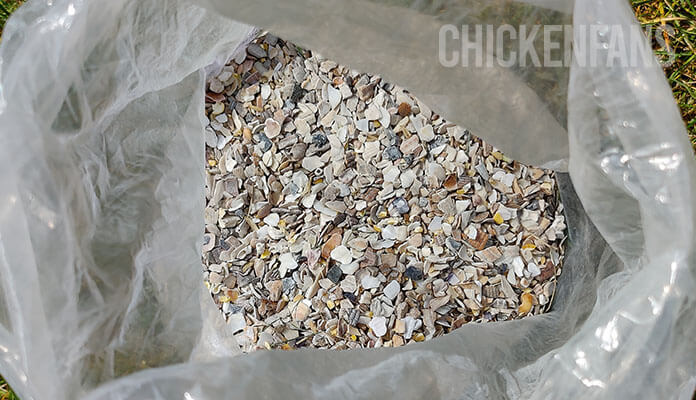
Probiotics are the safest way to boost a chicken’s health. These all-natural supplements not only promote a balanced gut but also boost the immune system and improve egg production.
Proteins are crucial for a chicken’s health, growth, feather development, and overall well-being.
Adequate calcium intake results in more eggs and stronger eggshells.
Outside Chicken Run
Chickens need to get some air and space to stretch their legs. However, they need a safe space to do so. A durable, strong metal chicken wire protects your flock from predators, such as hawks, snakes, weasels, and raccoons.
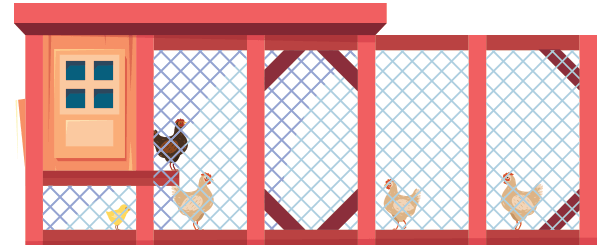
Make sure to cover the full chicken run. To prevent digging predators from entering, you must bury the fence in the ground.
Protect your chickens from smaller pests like rats and flies. They can cause serious health issues.
An automatic chicken coop door is a great idea if you want to prevent predators from entering the chicken coop at night. This way, your chickens are safely tucked in each night, and you don’t have to get up early to leave them out of the coop. The auto door does all that work for you.
If you want to know more about automatic chicken coop doors, check out our in-depth review of our Best Automatic Chicken Coop Door, or read our in-depth reviews of major brands like Omlet, ChickenGuard, Chickcozy, Happy Henhouse, Run Chicken and Vevor.
Temperature Regulation
A good coop provides shelter and protects your flock from rain, snow, and hot and cold temperatures. The temperature should be comfortable, or the hens stop laying eggs.
Chickens are pretty cold-hardy and can cope with cold temperatures in the winter. In the summer, proper ventilation is needed. If the coop becomes too hot, the water can become too warm, and they will stop drinking. Make sure to read about the do’s and don’ts to cool your chickens down in the summer.
Young chicks in the brooding period can not regulate their body temperature, so they need some external heat source.
Chicken Behavior
Chickens are social animals with their own characteristics.
Pecking Order
In the flock, not all chickens are equal. The bigger and stronger chickens are higher on the ladder and get to eat first.
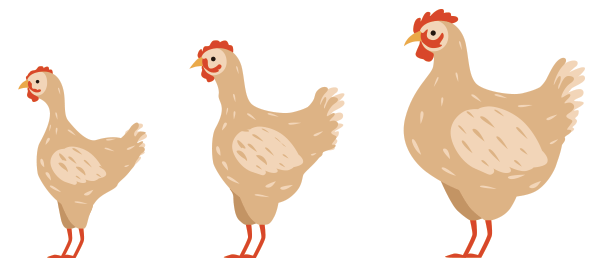
Chickens really peck on each other to establish their pecking order. And that is okay, as long as the bullying doesn’t get out of hand. If that happens, you probably have too many chickens or need more space. If a rooster shows aggressive behavior, you might have too many roosters for too few hens.
Chickens are sociable animals who need the company of fellow flock mates, and therefore you should never keep just one chicken. Keeping a minimum of three chickens is a general guideline, but two is an absolute minimum.
Some bullying or aggressive mating behavior can temporarily be solved with pinless peepers or chicken saddles.
Molting
Chickens change feathers every year, usually around the fall season. It’s called molting. Don’t be surprised if your coop and garden are covered with feathers. The whole process takes about 8 weeks but can stretch as long as 16 weeks.
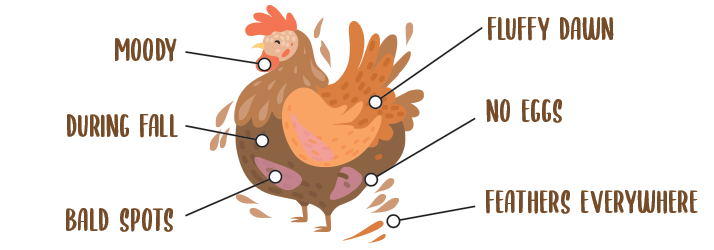
Some breeds change their feathers all at once, and others walk around all year with bald spots. Molting is uncomfortable for chickens, and many hens stop laying eggs.
To ensure proper growth of the new feathers, ensure enough protein in their food.
Dust Bathing
Chickens love to take a dust bath. They do this to clean their feathers from lice, mites, and parasites. Our beloved birds don’t like to take water baths as we do.
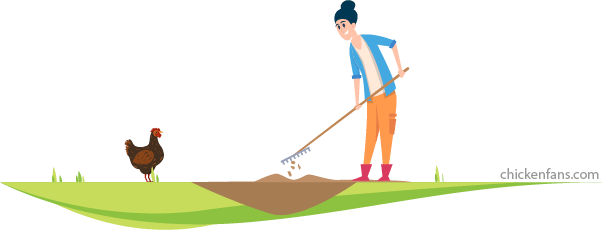
Make sure to have a spot where they can dust bathe, or they will pick their own spot in the garden. To do so, grab a container and fill it with builders’ sand. You can also add some ash: the charcoal contains vitamin K and calcium and absorbs toxins.
Eggs
Hens start to lay eggs when they are about 6 months old. Around that time, you’ll notice them squatting or crouching for you, a sign they’re reaching sexual maturity. Chances are you find their first egg soon after you see them squatting for the first time.
A chicken’s first egg may look weird, maybe smaller in size, or with a soft shell instead of a regular one. During their lifetime, chances are, they’ll lay some abnormal-looking eggs. Chickens lay all sorts of eggs: weirdly shaped, soft-shelled eggs with a strange texture, double yolk eggs, or fairy eggs.
You can collect eggs during spring and summer into fall. In their prime time, they produce 1 egg a day and continue to do so for the first couple of years. If you are lucky, chickens can lay two eggs in one day. With aging, it starts to slow down.
You don’t need a rooster for eggs. Hens always produce eggs, whether there is a rooster or not. Of course, without a rooster, the eggs won’t be fertilized. If you want chicks, you need a rooster.
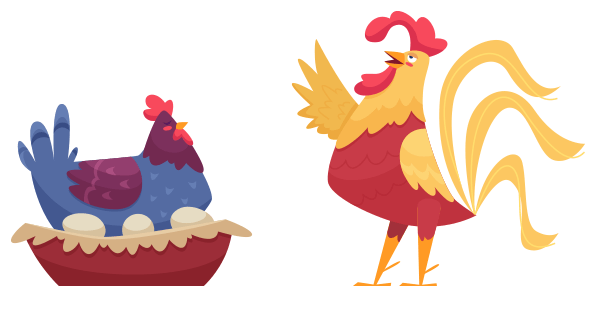
When the hens are cackling loudly, you know they are laying eggs. Most people check for eggs in the morning.
Broken Eggs
Always make sure to remove all the eggs, especially if they are broken!
Chickens love eggs, and when they figure out they can crack their own eggs, they will start picking them. Unfortunately, this habit is nearly impossible to combat, and other hens might start doing the same. So make sure to pick up the eggs every day.
Feeding Your Chickens
Laying hens are usually not that picky about what they eat. However, nothing beats a balanced diet. The foundation of their nutrition should be poultry feed.
When we are looking at the basic chicken feed, we have:
- chicken feed: general formula for egg layers, high in protein and calcium
- chicken scratch: a treat with seeds and grains (they will scratch the sand to get the last bit of it)
- oyster shell: extra source of calcium for strong eggshells
- chicken grit: helps proper digestion and grinding down the food; chickens don’t have teeth
- chicken treats: grains, seeds, bugs, and mealworms with supplements like omega-3
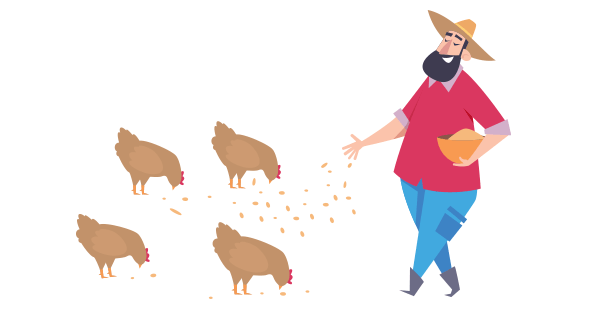
However, chickens love food and eat a lot more:
- weeds and flowers: ideal after weeding the garden for chickweed
- kitchen leftovers: beef, fish, pasta, rice, eggs; they are truly omnivores
- garden scraps: ideal if you are gardening and you have some scraps and leftovers
- small animals: chickens will hunt down small mice, lizards, snails, and frogs
What? Do they hunt animals?
Yes, they will hunt and eat small animals like snails and mice. In fact, having a chicken coop with food attracts rodents like mice and rats.
But you can’t just fight them with poison, or you will be poisoning your chickens too. So you better keep it clean, hide the food and get some cats or traps.
So you can give them everything you want?
Although chickens eat a lot, there are some things you can not feed them.
Some poor options might be less intuitive, like onions, grapes, tomato leaves, rhubarb, and pits from fruit. But it should be a no-brainer to never feed them with leftovers from the kitchen that contain alcohol, caffeine, sugar, fried food, chocolate, or ice cream. Some food comes with a warning, like grapes sprayed with toxic insecticides.
If you want pests like flies and rats to stay away from your chickens, removing all leftover food from the run is best.
All About The Chicks
We’ll never know which came first, the eggs or the chicks, but we do know how to hatch an egg and raise the chicks!
Hatching Eggs
Hatching Eggs is pretty easy and exciting. It takes about 21 days for a chick to break through the shell.
You will need some fertile eggs and an incubator to keep the eggs warm and the environment moist. If you don’t have an incubator, you can always look for a broody hen. Some incubators come with an automatic egg-turning system.
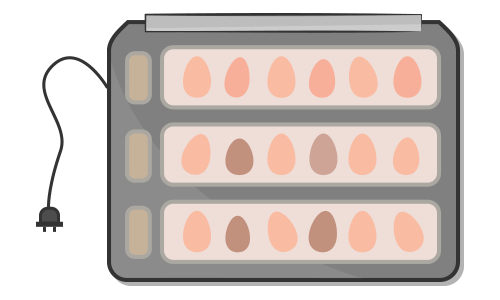
For the first 17 days, you will only have to keep the eggs warm and turn them around continuously. After that, stop turning the eggs and increase the incubator’s humidity.
Between days 20 and 23, the eggs will start to hatch. Just stand by and watch the beauty of nature.
After hatching, give the newborns 24 hours of rest to dry and relax in the incubator before you start feeding the fluffy chicks. If you decide to hatch your eggs, check our egg-hatching guide for a day-by-day plan.
Raising Chicks
Day-old chicks are raised in a brooder. They need a clean and safe environment to grow up.
The chicks will need a heat lamp, (chick) feeders, waterers, and clean bedding. They are pretty low maintenance but ensure the bedding and the water stay clean. They are not terribly smart and will spill food and poop in the water bowl.
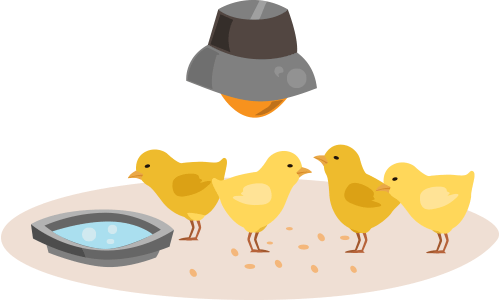
Chicks need special nutrition. A good starter crumble contains some medication against coccidiosis, a parasite. Always make sure they have access to some grit: they have no teeth and can’t chew their own food.
You can lower the temperature each week, and after 2 or 3 weeks, they can stick their head outside for the first time. After approximately 5 weeks, they can move from the brooder to the chicken coop. When they are six months old, the hens will start laying eggs.
Raising chicks is not too difficult and very exciting. Check our guide on raising baby chicks for some more in-depth tips and tricks.
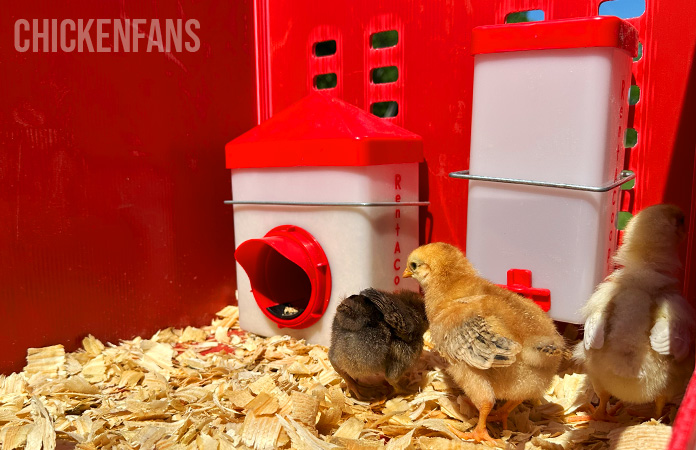
Protecting Your Chickens From Predators
Unfortunately, there are predators everywhere that can attack your flock. Wild animals like hawks, owls, foxes, coyotes, weasels, and snakes love a delicious chicken for lunch. Even if you live in a city, the neighbor’s domestic pet dog or cat could be very interested in your chickens.
You need to protect the chicken coop from attacks coming from the top, the side, or the bottom. Make sure to have fencing and chicken wire everywhere. Bury the fence in the ground for digging predators. There should not be any holes in the coop, and the coop should have a strong (automatic) coop door to prevent entrance from unwanted visitors.

One way to protect your flock is to get a rooster. The rooster will scan the sky for hawks and flying predators and warn the hens of incoming danger. The hawks get discouraged by a big puffed-up rooster.
Common Chicken Health Problems
Chickens are living creatures and come with their own set of health issues. Observe your flock for any abnormal behavior. Are they eating enough? Are they energetic? Do they have abnormal droppings?
Unfortunately, there are some common health issues that can occur when raising chickens. Let’s take a look at some of the most frequent issues.
Hens that stop laying eggs
There are many reasons why hens might be slowing down on their eggs. It could be something innocent, like the start of a molt, but it can also result from an underlying condition.
Common issues that prevent egg-laying are parasites, stress, vitamin deficiencies, or diseases. If vitamin and oyster shell supplements don’t help, contact a vet.
You need to understand that chickens don’t lay eggs around the clock all the time. Egg production is a complex process that usually takes anywhere from 23 to 36 hours.
Any sudden stress or disturbance during that period can cause the chickens to halt the process and stop laying eggs like normal. It will take a while for them to calm down and return to their routine.
Foot Problems
A lot of foot problems start with an infected wound. The result is that the chickens don’t enjoy wandering around. They take their time on the perches or in the nesting box. To treat cuts, clean the foot with wound wash.
A common condition is Bumblefoot, where the foot is swollen and red due to a bacterial infection. This must be treated to prevent the infection from spreading.
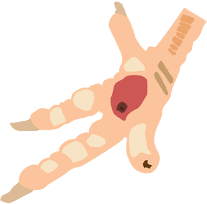
If left untreated, bumblefoot is dangerous. First, it spreads locally, affecting bones and tendons. Then, in severe cases, it enters the chicken’s bloodstream, causing systemic infection (septicemia).
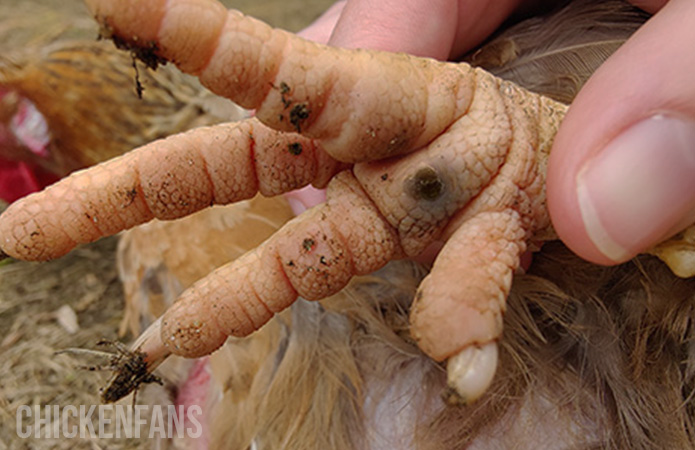
Parasites
Common external parasites are lice, mites, ticks, and chiggers. Left untreated, they can cause feather loss, egg-laying issues, weight problems, scaly leg mites, and many other issues.
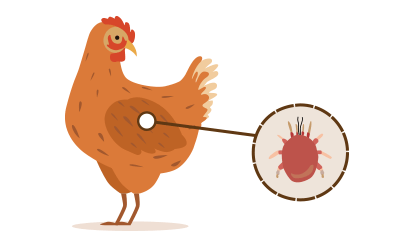
Make sure the chickens have a dust bath with sand to wallow to clean their feathers.
Bacterial and Viral diseases
Bacterial and viral diseases are the enemy of the coop as they can spread very rapidly. Infectious diseases include bronchitis, Marek’s disease, Fowl Pox, avian flu, Newcastle Disease, and Coccidiosis. If your chickens are coughing and sneezing, think of a viral infection. Bacterial diseases include colibacillosis (E. coli) and salmonellosis (Salmonella). Good thing they are less common.
Always observe their behavior and look for common signs of illness, like pale comb, black spots on the chicken’s comb, lack of appetite, lethargy, bloody droppings, or yellow diarrhea.
Pasty Vent
Sometimes, the droppings of baby chicks start to clutter under their tail. This can block the vent and prevent the chick from passing droppings.
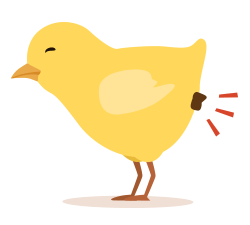
This is called pasty vent (or pasty butt). When raising small chicks, make sure to check for a pasty vent!
Wrap Up
As you can see, chickens are pretty low-maintenance and easy to raise. You can even hatch your own eggs!
We encourage you to read on and ask any questions in the comments.
Happy raising!

